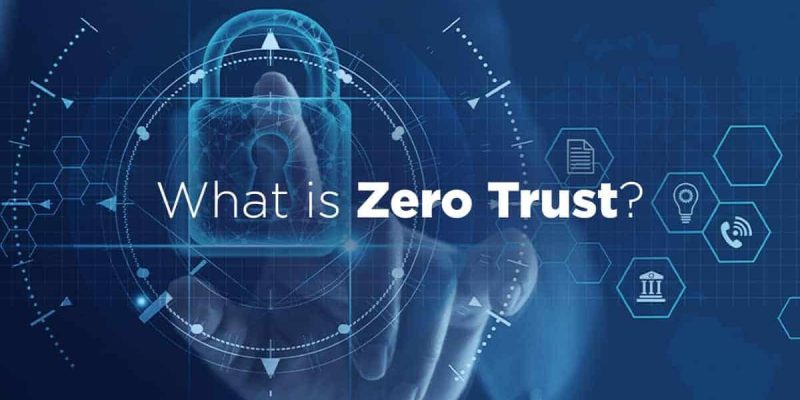In today’s digital landscape, the concept of Zero-Trust Security has gained significant traction, evolving from its initial focus on network security to a comprehensive approach that encompasses users, devices, and applications. According to a 2023report by IBM, the average cost of a corporate data breach is $4.45 million, emphasizing the critical need for robust security measures like Zero-Trust. Furthermore, the Pentagonis actively reviewing its Zero-Trust cybersecurity strategy, indicating its military-grade robustness and relevance in safeguarding national security.
Given the growing importance of Zero-Trust security, this guide will explain its core principles, discuss why it’s becoming the go-to security model, and explore how to implement it effectively.
The Principles of Zero-Trust Security
Core Concepts: “Never Trust, Always Verify”
The foundational principle of Zero Trust Security is “Never Trust, Always Verify.” This mantra means that the trust should not be assumed based on any factor, such as network location or previous interactions. Instead, every request for access to a network resource should be authenticated, authorized, and encrypted before granting any access.
The good news is according toFortra’s 2023 Zero-Trust Security Report, enterprises are increasingly adopting this principle, in response to enhanced cybersecurity and data protection needs.
Least-Privilege Access
Another cornerstone of Zero-Trust Security is the concept of least-privilege access. This means that users (or systems) are given the minimum levels of access — or permissions — they need to perform their tasks.
A Gartner reportpublished in April 2023 emphasizes the importance of least-privilege access in optimizing an organization’s risk posture.
Micro-Segmentation
Micro-segmentation involves breaking up security perimeters into small zones and maintaining separate access for separate parts on the network. And even if a malicious actor gains access to one segment, they won’t have access to other segments.
The good news is the market value of the Zero-Truststands at 23 billion USD, indicating significant investment in technologies like micro-segmentation.
Identity and Access Management (IAM)
IAM is another factor that plays a crucial role in Zero-Trust Security. So, only authenticated and authorized users can access the data and applications.
The good news is according to Statista, familiarity with Zero-Trust in North America stands at 64%, suggesting a growing awareness and implementation of IAM principles.
Military-Grade Security
The Department of Defense (DoD) has adopted Zero-Trust principles, emphasizing the model’s robustness and applicability in high-stakes environments like national security.
In fact,theDoD Zero-Trust Reference Architecture wasreferred to in an OMB memorandum in January 2022, highlighting its importance in evolving cybersecurity paradigms.
Why Zero Trust Security is Essential
Addressing the Escalating Cyber Threat Landscape
The traditional security models are proving to be inadequate in the face of today’s sophisticated cyber threats. Zero Trust Security, with its “Never Trust, Always Verify” principle, offers a more robust line of defense.
Security measures like these are important, given the increased level of data breaches in organizations. In fact, according to areport by JumpCloud, the average cost of a data breach rose from $4.24 million in 2021 to $4.35 million in 2022, representing a 2.6% increase.

There is No Gap Between Small and Large Businesses When It Comes to CyberThreats
Zero Trust Security is not just for large enterprises; it’s equally beneficial for small businesses.
In fact,the gap in attack frequency between small and large businesses is closing. In 2020, SMEs experienced as much as half the number of attacksas large enterprises did.
Military-Grade Robustness
The Pentagon’s active review of its Zero Trust cybersecurity strategy indicates the model’s robustness and its potential for safeguarding national security.
Financial Benefits and ROI
Implementing Zero Trust Security can offer significant cost savings as it prevents data breaches and reduces the scope of compliance audits.
That is why the Zero Trust is now the top security priority for 96% of security decision-makers, indicating its critical role in an organization’s financial health.
Implementation Guide: How to Adopt Zero Trust Security
Implementing Zero Trust Security involves various technologies, stages, and best practices. Here’s a step-by-step guide to help you:
Step 1: Conduct a Risk Assessment
Identify vulnerabilities and understand the organization’s specific security needs.
Step 2: Define Security Policies
Clear security policies should outline the rules for access control, data protection, and network segmentation.
Step 3: Choose the Right Technologies
Ensure to select the technologies that align with your Zero Trust Security model. For instance, Identity and Access Management (IAM) solutions, multi-factor authentication (MFA), and endpoint security software.
Step 4: Implement Least-Privilege Access
Apply the least-privilege access principle. For this, limit user permissions to only what is necessary for their job functions.
Step 5: Deploy Micro-Segmentation
Micro-segmentation allows you to divide the network into smaller and isolated segments. This allows you to limit lateral movement in case of a security breach in your organization.
Step 6: Monitor and Audit
Continuous monitoring and auditing are essential once the Zero-Trust framework is in place. Use analytics tools to track user behavior and access patterns.
Step 7: Train Employees
Employee training is a critical component. Educate staff on the importance of cybersecurity and how to adhere to the new Zero Trust policies.
Step 8: Review and Update
Regularly review and update the Zero Trust Security measures to adapt to new threats and technologies. This should be an ongoing process.
Challenges and How to Overcome Them
Implementing Zero Trust Security comes with its own set of challenges.
Challenge 1: Complexity of Implementation
Zero Trust involves multiple technologies and layers of security, so the implementation process is complex.
- Solution: Start small by focusing on critical assets and gradually expand the Zero Trust framework. Employ a phased approach to manage complexity.
Challenge 2: Resistance to Change
Employees may resist the new security measures, finding them cumbersome or restrictive.
- Solution: Conduct training sessions and workshops to educate employees on the importance of Zero Trust Security. Make sure to communicate the benefits clearly.
Challenge 3: Budget Constraints
Implementing a Zero Trust model can be expensive, especially for small to medium-sized businesses.
- Solution: Prioritize the most critical assets and implement Zero Trust measures in stages to spread out the costs. Look for budget-friendly solutions that offer good value.
Challenge 4: Lack of Expertise
Organizations may lack the in-house expertise needed to implement and manage a Zero Trust model effectively.
- Solution: Consider hiring external consultants or investing in training for existing staff. There are also managed Zero-Trust services that can handle the implementation for you.
Challenge 5: Compatibility Issues
Zero Trust Security measures are not often compatible with legacy systems, and may require upgrades or replacements.
- Solution: Conduct a thorough assessment of existing systems to identify compatibility issues. Plan for necessary upgrades or find workarounds to integrate Zero Trust measures.
Conclusion
Zero-Trust’s principle of “Never Trust, Always Verify,” least-privilege access, and micro-segmentation is enough to make any organization know its importance. The question is what’s stopping you?

















Comments